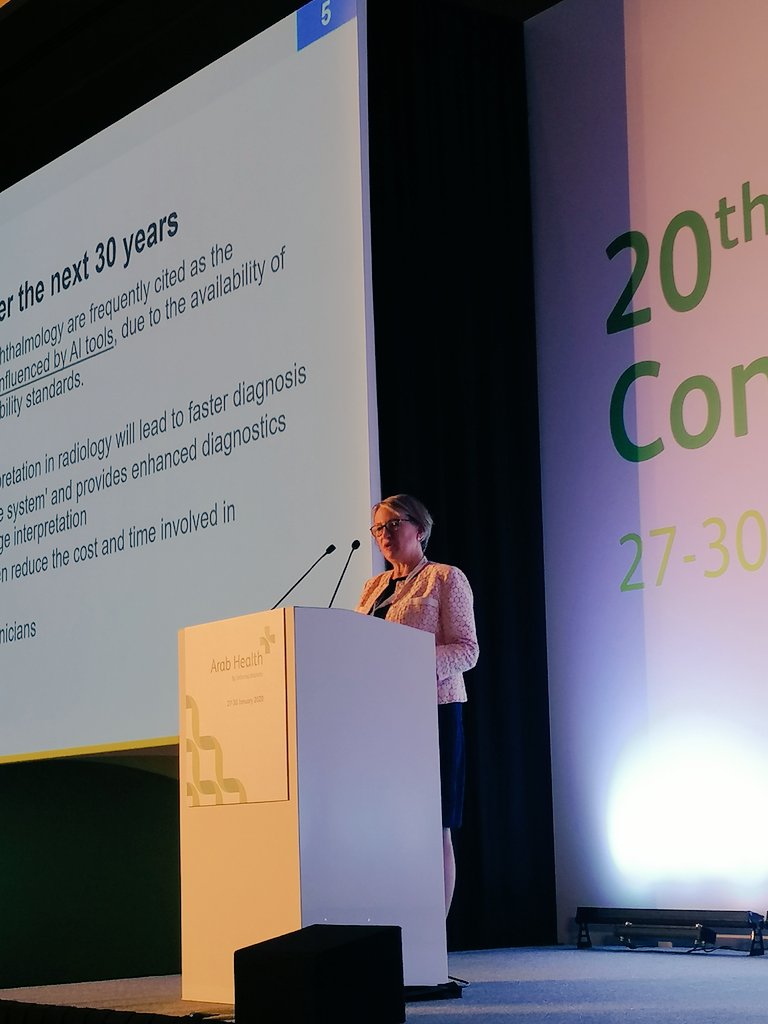The Society's director of professional policy is the first radiographer to have given the keynote presentation at the annual Total Radiology Conference, part of Arab Health 2020 in Dubai.
Charlotte Beardmore spoke about 'What will radiology and the role of the radiographer look like in 30 years?'
In her role as vice-president of the European Federation of Radiographer Societies (EFRS), Charlotte talked about the role of the radiographer, now and in the future.
"The headline is artificial intelligence (AI)," she said. "Deep learning and machine learning and the benefits this may bring to improving outcomes for patients.
"We are nervous about getting into driverless cars. We should equally be aware of the risks of AI and machine learning introduced without appropriate governance, audit and human intervention in its development. However, we cannot bury our heads and we must engage in this exciting future."
She told delegates about the SoR's newly published artificial intelligence policy statement to continue to champion high quality radiographic practice in diagnostic and radiotherapy services.
In the next 30 years, Charlotte anticipates that:
- Automated image interpretation in radiology will lead to faster diagnosis
- Deep learning will 'train the system' and provide enhanced diagnostics through automated image interpretation
- Trained systems will reduce the cost and time involved in analysing scans
- AI will work alongside clinicians
She asked for caution and said there is a danger that the message to the public is "too simplistic" and may lead to unrealistic expectations. Also, to save money and speed up adoption, government may apply one line of research across all imaging data sets, which could lead to decreased investment in the workforce and attempts to make a single algorithm fit all applications.
Charlotte predicted that increasing access to and use of 'big data' for research will optimise diagnostics. However, there are issues of governance to be considered about data use, the regulation of algorithms, and business continuity.
Where does this 'brave new world' leave radiographers?
"The core role of the radiographer is patient facing," Charlotte said. "Supportive, information giving, obtaining legal consent, focusing on safety, follow up, and next steps in the pathway. This role will still need to exist and can grow to better support for patient care through one stop clinics offering integration of all data.
"What should stop radiographers informing patients when there are normal pathologies, or higher level practitioners referring patients on for care to support their needs, reducing pathway delays and streamlining care for patients?
"We have published evidence of this already in practice with advanced and consultant practitioners in the UK leading pathways of care within a clear role, within a supportive team, and with clear protocols."
She told delegates that the future will require:
- An ongoing review of undergraduate Knowledge, Skills, Competence (KSC)
- Informing regulatory frameworks enabling timely changes
- Investment at European and national levels to develop the KSC of radiographers
- Responsive education and training at Masters level, reflecting service needs
- Investment in Doctoral level education for the profession
Charlotte said, "Radiographers will need to re-engineer their roles in health care. This will include being patient pathway leaders, carrying out faster imaging procedures with reduced dose, having an active role in preventative medicine, and using different educational environments to learn."
She advised delegates that radiographers will develop patient pathway management skills including triage, discharge, and referral. They will need to understand specialist and new pathways such as the integration of genomics, health economics, and understand work flow optimisation.
She said that scientific skills will remain core, statistical analysis will be more important, as will greater understanding and use of AI, DL and ML. Other required knowledge and skills will be more advanced informatics, including big data sets and governance, higher level research and audit skills, developed digital competencies, and embracing and working with new technologies.
In addition, increasingly important will be understanding specialist and new pathways, the evaluation of and implementation of new technologies, enhanced high level communication skills, and understanding compassionate care to match patient needs.
Charlotte explained that in the UK work is beginning on the review of the Education and Career Framework for radiographers. It will include a review of the pre-registration education for professional practice to develop practitioner outcomes and a revised indicative curriculum that will meet the demands of the future imaging and oncology workforce.
The SoR is contributing to a review of the regulatory standards for the profession this summer. She highlighted how important it is that the standards of proficiency defined by regulators and professional body standards keep pace with change.
Charlotte finished her presentation with a quote by Maya Angelou, the poet and civil rights campaigner, "I've learned that people will forget what you said, people will forget what you did, but people will never forget how you made them feel."
